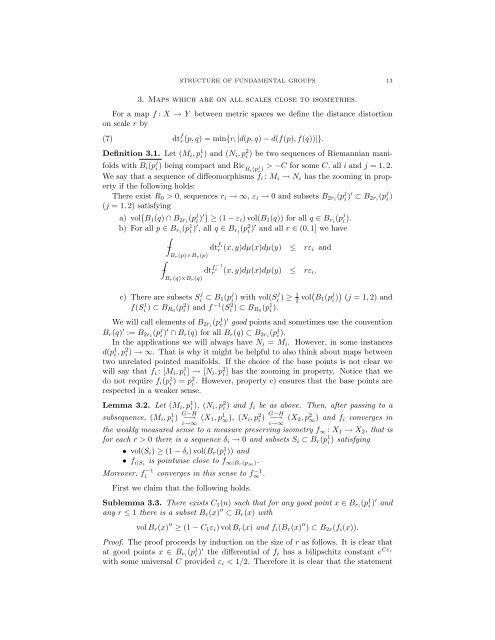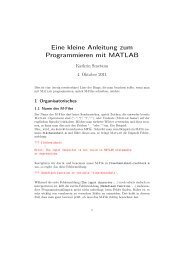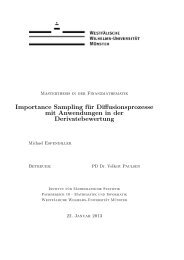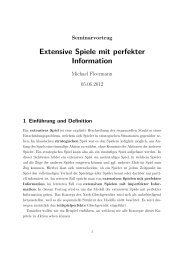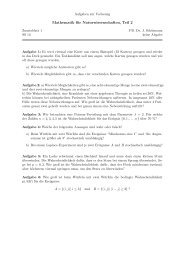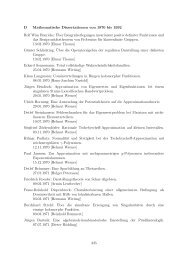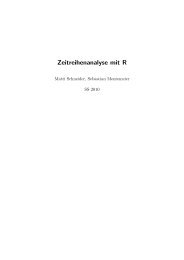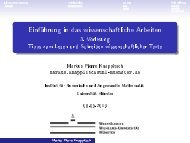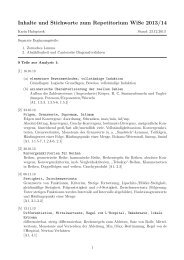Margulis Lemma
Margulis Lemma
Margulis Lemma
Create successful ePaper yourself
Turn your PDF publications into a flip-book with our unique Google optimized e-Paper software.
STRUCTURE OF FUNDAMENTAL GROUPS 13<br />
3. Maps which are on all scales close to isometries.<br />
For a map f : X → Y between metric spaces we define the distance distortion<br />
on scale r by<br />
(7) dt f r (p, q) = min{r, |d(p, q) − d(f(p), f(q))|}.<br />
Definition 3.1. Let (M i , p 1 i ) and (N i, p 2 i ) be two sequences of Riemannian manifolds<br />
with B i (p j i ) being compact and Ric B i(p j i )<br />
> −C for some C, all i and j = 1, 2.<br />
We say that a sequence of diffeomorphisms f i : M i → N i has the zooming in property<br />
if the following holds:<br />
There exist R 0 > 0, sequences r i → ∞, ε i → 0 and subsets B 2ri (p j i )′ ⊂ B 2ri (p j i )<br />
(j = 1, 2) satisfying<br />
a) vol ( B 1 (q) ∩ B 2ri (p j i )′) ≥ (1 − ε i ) vol(B 1 (q)) for all q ∈ B ri (p j i ).<br />
b) For all p ∈ B ri (p 1 i )′ , all q ∈ B ri (p 2 i )′ and all r ∈ (0, 1] we have<br />
∫<br />
− dt fi<br />
r (x, y)dµ(x)dµ(y) ≤ rε i and<br />
B<br />
∫ r(p)×B r(p)<br />
− dt f −1<br />
i<br />
r (x, y)dµ(x)dµ(y) ≤ rε i .<br />
B r(q)×B r(q)<br />
c) There are subsets S j i ⊂ B 1(p j i ) with vol(Sj i ) ≥ 1 2 vol( B 1 (p j i )) (j = 1, 2) and<br />
f(S 1 i ) ⊂ B R 0<br />
(p 2 i ) and f −1 (S 2 i ) ⊂ B R 0<br />
(p 1 i ).<br />
We will call elements of B 2ri (p 1 i )′ good points and sometimes use the convention<br />
B r (q) ′ := B 2ri (p j i )′ ∩ B r (q) for all B r (q) ⊂ B 2ri (p j i ).<br />
In the applications we will always have N i = M i . However, in some instances<br />
d(p 1 i , p2 i ) → ∞. That is why it might be helpful to also think about maps between<br />
two unrelated pointed manifolds. If the choice of the base points is not clear we<br />
will say that f i : [M i , p 1 i ] → [N i, p 2 i ] has the zooming in property. Notice that we<br />
do not require f i (p 1 i ) = p2 i . However, property c) ensures that the base points are<br />
respected in a weaker sense.<br />
<strong>Lemma</strong> 3.2. Let (M i , p 1 i ), (N i, p 2 i ) and f i be as above. Then, after passing to a<br />
subsequence, (M i , p 1 i ) G−H<br />
−→ (X 1, p 1 ∞), (N i , p 2 i ) G−H<br />
−→ (X 2, p 2 ∞) and f i converges in<br />
i→∞ i→∞<br />
the weakly measured sense to a measure preserving isometry f ∞ : X 1 → X 2 , that is<br />
for each r > 0 there is a sequence δ i → 0 and subsets S i ⊂ B r (p 1 i ) satisfying<br />
• vol(S i ) ≥ (1 − δ i ) vol(B r (p 1 i )) and<br />
• f i|Si is pointwise close to f ∞|Br(p ∞).<br />
Moreover, f −1<br />
i<br />
converges in this sense to f −1<br />
∞ .<br />
First we claim that the following holds.<br />
Sublemma 3.3. There exists C 1 (n) such that for any good point x ∈ B ri (p 1 i )′ and<br />
any r ≤ 1 there is a subset B r (x) ′′ ⊂ B r (x) with<br />
vol B r (x) ′′ ≥ (1 − C 1 ε i ) vol B r (x) and f i (B r (x) ′′ ) ⊂ B 2r (f i (x)).<br />
Proof. The proof proceeds by induction on the size of r as follows. It is clear that<br />
at good points x ∈ B ri (p 1 i )′ the differential of f i has a bilipschitz constant e Cεi<br />
with some universal C provided ε i < 1/2. Therefore it is clear that the statement


